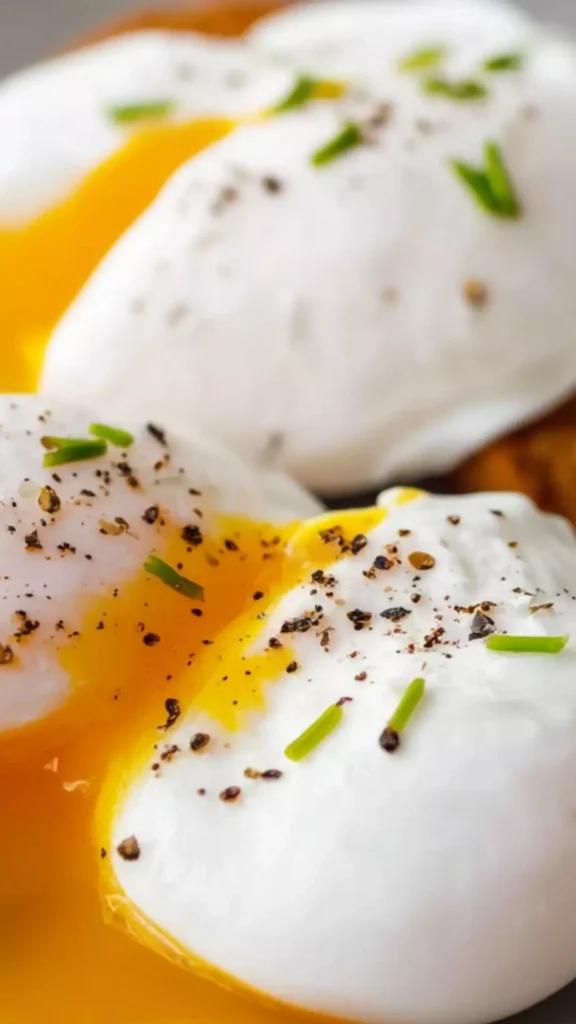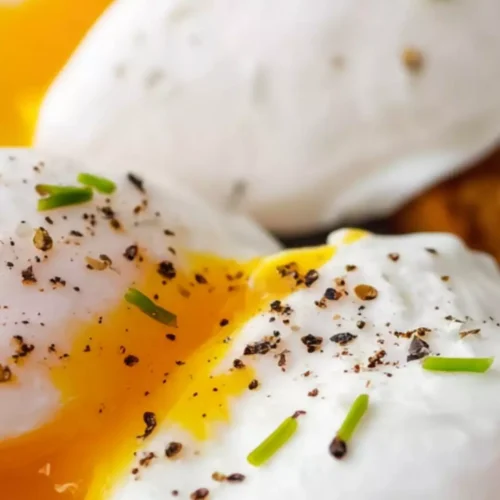If there’s one dish that turns a simple breakfast into an elegant morning indulgence, it’s a perfectly poached egg. Don’t you just love that feeling when you slice into one?
The egg white gives way, and that golden yolk spills out, ready to coat your toast or mingling with sautéed spinach. But where did this divine creation of breakfast happiness come from?
And how can you make it just right in your own kitchen? Sit tight, and let’s explore the ins and outs of poached eggs.

What is a Perfect Poached Egg?
A perfect poached egg is not just a culinary treat; it’s an experience. Imagine the tender egg white cradling the luscious, runny yolk. The flavor is rich, yet delicate. It pairs wonderfully with salads, toasts, or even standalone, seasoned with just a sprinkle of salt and pepper.
The magic lies in its simplicity. All you need is a few ingredients and some techniques that I’m excited to share with you.
The Ingredients
To create this breakfast wonder, you need:
- 1 large egg
- 1 to 2 tablespoons vinegar, optional
- 1 teaspoon lemon juice (optional)
- A pinch of salt (optional)

How to Make Perfect Poached Eggs
Before we dive into the steps, let’s just say there’s a little art to this. It’s about timing and temperature, but don’t worry! I’ll guide you through it, step by step, so you can confidently prepare poached eggs at home.
Step 1: Prepare Your Ingredients
Gather everything and bring a pot of water to a gentle simmer. I usually use a wide saucepan that allows for ample water flow, which is essential for proper poaching.
If you choose to use vinegar or lemon juice, have it close by.
Step 2: Crack the Egg
Crack your egg into a small bowl. This makes it easier to slide into the water without breaking the yolk. Plus, it’s a little less stressful than trying to crack it directly into the pot.
Step 3: Create a Vortex (Optional)
Some swear by this method. Stir the simmering water gently to create a whirlpool. This motion can help the egg white wrap around the yolk, resulting in a more compact shape.
Step 4: Slide the Egg In
Gently slide the egg from the bowl into the center of the simmering water. If you’re using vinegar, now’s the time to add it. Step back and let the water do its magic without stirring.
Step 5: Time It Right
Cook the egg for 3 to 4 minutes. You want the whites to firm up, while the yolk stays runny. Keep an eye on it as it cooks; you can adjust the time depending on how soft or firm you prefer your yolk.
Step 6: Remove the Egg
Using a slotted spoon, carefully lift the egg out of the water. Let it drain and use a paper towel to remove excess water.
Step 7: Season and Serve
Serve your poached egg right away. A sprinkle of salt and pepper elevates the dish, allowing those flavors to shine through.
Notes
Here are some helpful tips to ensure your poached egg perfection:
- Fresh Eggs Matter: Fresh eggs hold together better during poaching, giving you that ideal shape.
- Water Temperature: Keep the water at a gentle simmer. High boiling can lead to frayed edges of the egg white.
- Vinegar Guidance: If you opt to use vinegar, choose a mild type so it doesn’t overpower the egg’s flavor.
- Practice Makes Perfect: Don’t be disheartened if your first egg doesn’t look Instagram-perfect. Keep at it!
- Serving Immediately: Poached eggs are best served right away. If you need to hold them, place them in cool water until ready to serve.
Storage Tips
Poached eggs are best enjoyed fresh, but if you have leftovers, you can store them:
- Refrigerate for up to two days. Keep them in a container with a little water to maintain moisture.
- To reheat, briefly immerse them in simmering water for about 30 seconds. This makes them warm and ready to eat.

Serving Suggestions
Here are some delightful ways to enjoy your poached eggs:
- On Toast: Toast a slice of whole-grain or sourdough bread, then place the poached egg on top. Add smashed avocado or a sprinkle of chili flakes for spice.
- In a Salad: Top a green salad with poached eggs for added protein. It pairs well with mixed greens, cherry tomatoes, and a light vinaigrette.
- With Smoked Salmon: Elevate your breakfast by placing a poached egg on a platter of smoked salmon, capers, and cream cheese on a bagel.
- On a Breakfast Bowl: Build a breakfast bowl with grains like quinoa or farro, add vegetables, and top with a poached egg.
- On Pizza or Flatbreads: Make a brunch pizza, topping your favorite crust with vegetables and a poached egg for a creative twist.
Other Substitutes for Perfect Poached Eggs
If you’re looking to change things up, consider these alternatives:
- Egg Whites Only: Use just egg whites for a lighter option. They’ll still poach beautifully and are lower in calories.
- Duck Eggs: Try poaching duck eggs. They have a richer flavor and unique texture that some find delightful.
- Quail Eggs: Make a fancy brunch with poached quail eggs. Their size requires less cooking time, so watch them carefully.
- Tofu: For a vegan alternative, you can attempt to poach silken tofu. It won’t be the same, but can provide a unique texture and can work well in Asian-inspired dishes.
- Plant-Based Eggs: Explore consumables made from chickpeas or other plant ingredients, created to mimic the flavor and texture of eggs.

Perfect Poached Eggs Recipe
Equipment
- Saucepan
Ingredients
- 1 large egg
- 1 to 2 tablespoons vinegar optional
- 1 teaspoon lemon juice optional
- A pinch of salt optional
Instructions
- Gather everything and bring a pot of water to a gentle simmer. I usually use a wide saucepan that allows for ample water flow, which is essential for proper poaching.
- If you choose to use vinegar or lemon juice, have it close by.
- Crack your egg into a small bowl. This makes it easier to slide into the water without breaking the yolk. Plus, it’s a little less stressful than trying to crack it directly into the pot.
- Some swear by this method. Stir the simmering water gently to create a whirlpool. This motion can help the egg white wrap around the yolk, resulting in a more compact shape.
- Gently slide the egg from the bowl into the center of the simmering water. If you’re using vinegar, now’s the time to add it. Step back and let the water do its magic without stirring.
- Cook the egg for 3 to 4 minutes. You want the whites to firm up, while the yolk stays runny. Keep an eye on it as it cooks; you can adjust the time depending on how soft or firm you prefer your yolk.
- Using a slotted spoon, carefully lift the egg out of the water. Let it drain and use a paper towel to remove excess water.
- Serve your poached egg right away. A sprinkle of salt and pepper elevates the dish, allowing those flavors to shine through.
Notes
- Fresh Eggs Matter: Fresh eggs hold together better during poaching, giving you that ideal shape.
- Water Temperature: Keep the water at a gentle simmer. High boiling can lead to frayed edges of the egg white.
- Vinegar Guidance: If you opt to use vinegar, choose a mild type so it doesn’t overpower the egg’s flavor.
- Practice Makes Perfect: Don’t be disheartened if your first egg doesn’t look Instagram-perfect. Keep at it!
- Serving Immediately: Poached eggs are best served right away. If you need to hold them, place them in cool water until ready to serve.
Nutrition
Frequently Asked Questions
Conclusion
In the culinary landscape, the perfect poached egg stands as a versatile hero of breakfast. It graces toast, elevates salads, and even makes simple dishes shine. With a few easy techniques and some practice, you can master this delightful dish.
Remember, the journey of cooking is all about having fun and indulging your taste buds while trying something new. Let’s make every breakfast a little more special, one poached egg at a time!


